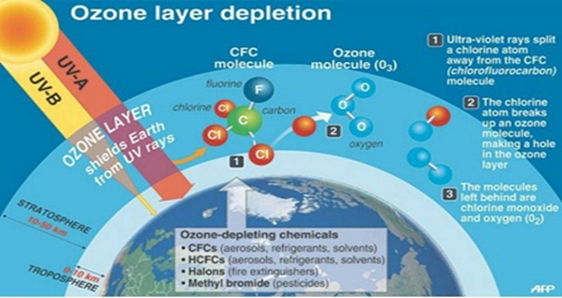

13th October 2023 (10 Topics)
Context:
Recently, the Satellite measurements over Antarctica have detected a giant hole in the ozone layer.
About the information:
- The hole also called as “ozone-depleted area” was identified of around 26 million square kilometers (10 million square miles) in size, roughly three times the size of Brazil.
- The European Space Agency Copernicus Sentinel-5P satellite made the recordings, as part of the EU’s environmental monitoring program.
The Ozone Layer:
- Ozone is a special form of oxygen, made up of three oxygen atoms rather than the usual two oxygen atoms.
- It usually forms when some type of radiation or electrical discharge separates the two atoms in an oxygen molecule (O2), which can then individually recombine with other oxygen molecules to form ozone (O3).
- The ozone layer is a trace gas in the stratosphere, one of the four layers of the Earth’s atmosphere.
- It functions as a protective gas shield that absorbs ultraviolet radiation, protecting humans and ecosystems from dangerous amounts of UV.
|
Most skin cancers are caused by exposure to high amounts of UV radiation, so anything that shields us from UV rays helps reduce cancer rates. |
What is Ozone hole?
- An ozone hole is the thinning of the ozone layer boosted in size by colder temperatures.
- As the temperature high up in the stratosphere starts to rise, ozone depletion slows, the polar vortex weakens and breaks down.
- By the end of December, ozone levels return to normal. This time around, however, the process took longer.
- The formation of ozone hole in the Antarctic has been an annual occurrence and has been recorded for the last 40 years.
- Human-made chemicals migrate into the stratosphere and accumulate inside the polar vortex.
- It begins to shrink in size as warmer temperatures dominate.
The science behind Human induced ozone depletion:
- Ozone depletion occurs when chlorofluorocarbons (CFCs) and halons (gases formerly found in aerosol spray cans and refrigerants) are released into the atmosphere.
- Ozone sits in the upper atmosphere and absorbs ultraviolet radiaton, another type of solar energy that's harmful to humans, animals and plants.
- CFCs and halons cause chemical reactions that break down ozone molecules, reducing ozone's ultraviolet radiation-absorbing capacity.
Factors contributing to natural Ozone depletion:
- Volcanic eruptions
- Increase in Ocean temperature
- Antarctica’s atmospheric action
- Planetary Winds over Antarctica
Does always Ozone layer depletion is Human caused?
- According to scientists, the size of the ozone hole over Antarctica fluctuates each year, opening each year in August and closing again in November or December.
- Ozone hole opens up because of the rotation of the Earth causing specials winds over the closed landmass of Antarctica.
- The winds create a mini climate, creating a shield over Antarctica preventing it from mixing with surrounding air. When the winds die down, the hole closes.

More Articles


